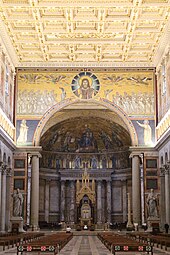801 Apennine earthquake
An
Both the Annals and the Liber date the event to 30 April according to contemporary Roman practice, whereby the day began at sundown. The Annals specify that it happened at the second hour of the night, which corresponds to 20:00 (8:00 p.m.) on 29 April by modern reckoning.[1] The Annals record the event from the perspective of the Frankish king Charlemagne, who had been crowned Roman emperor on 25 December 800 and had left Rome on 25 April for Spoleto, where he was staying when the earthquake struck.[2][3] They do not record the damage at Spoleto.[1] Charlemagne was unharmed,[2] but perhaps spooked.[4]

The quake was severe, with an estimated magnitude at Rome of VII–VIII on the
Archaeology has revealed several buildings damaged or destroyed by earthquakes which may have been victims of that of 801.
The Annals shows that the earthquake caused landslides.[1] It could not have caused a tsunami in the Adriatic, although it has been conflated in some sources with a possible tsunami-causing earthquake of 792 in the northern Adriatic.[13]
Primary sources
- Royal Frankish Annals:
While [Charlemagne] was staying [in Spoleto], on April 30, in the second hour of the night, a tremendous earthquake occurred which severely shook the whole of Italy. Because of this tremor a large part of the roof of the basilica of the blessed apostle Paul with its wooden framework collapsed, and in some places mountains tumbled on top of cities. In the same year also some places along the Rhine, in Gaul, and in Germany were hit with tremors.[14]
- Liber Pontificalis:
In the 9th indiction the menace of our sins brought about a sudden earthquake on 30 April. The earthquake shook St Paul's church and all the roofing collapsed. Seeing this, the great and distinguished pontiff [Leo III] was greatly afflicted and began to bewail the damage and destruction to the silver and other valuables therein. But by the Lord's will and by the prince of the holy apostles' protection, the pontiff put all his efforts into the task of restoring it as it was of old.[15]
- There are several other medieval sources which mention the earthquake, but these are derivative of the two Annales Mettenses and Annales Ratisponenses, as well as the works of Regino of Prüm, Hermann of Reichenau, Bernold of Constance, the Annalista Saxo, Petrus Comestor and Ptolemy of Lucca.[11]
Notes
- ^ a b c d e f Guidoboni et al. 2018.
- ^ a b Nelson 2019, p. 387.
- ^ Fried 2016, p. 438.
- ^ According to Fried 2016, p. 34, "Charlemagne personally saw earthquakes ... as unmistakable signs of God's wrath."
- ^ a b Cataldi 2022, p. 93.
- ^ Galadini et al. 2018, p. 322.
- ^ Guidoboni et al. 2018 and Camerlenghi 2012, p. 269, based on Liber 98:31, in Davis 1992, pp. 191–192. See also Davis's note 79.
- ^ Davis 1992, p. 192, n. 80.
- ^ Camerlenghi 2018, pp. 130–131.
- ^ a b Galadini et al. 2018, pp. 336–338.
- ^ a b Guidoboni, Comastri & Traina 1994.
- ^ Nelson 2019, p. 78.
- ^ Guidoboni & Tinti 1988, critiquing Caputo & Faita 1982.
- s.a. 801, in Scholz 1970, p. 81.
- ^ Liber 98:31, in Davis 1992, pp. 191–192.
Bibliography
- Camerlenghi, Nicola (2012). "Interpreting Medieval Architecture Through Renovations: The Roof of the Old Basilica of San Paolo in Rome". In Mark J. Johnson; Robert Ousterhout; Amy Papalexandrou (eds.). Approaches to Byzantine Architecture and its Decoration: Studies in Honor of Slobodan Ćurčić. Routledge. pp. 259–276.
- Camerlenghi, Nicola (2018). St. Paul's Outside the Walls: A Roman Basilica, from Antiquity to the Modern Era. Cambridge University Press.
- Caputo, Michele; Faita, G. F. (1982). "Statistical Analysis of the Tsunamis of the Italian Coasts". Journal of Geophysical Research. 87 (C1): 601–604. .
- Cataldi, Daniele (2022). "Lake of Nemi, Rome Italy – Archaeological Research near an Ancient Roman-period Dock Covered by a Landslide". International Journal of Social Relevance & Concern. 10 (4): 91–112.
- Davis, Raymond, ed. (1992). The Lives of the Eighth-Century Popes (Liber Pontificalis): The Ancient Biographies of Nine Popes from AD 715 to AD 817. Liverpool University Press.
- Fried, Johannes (2016) [2013]. Charlemagne. Translated by Peter Lewis. Harvard University Press.
- Galadini, Fabrizio; Ricci, Giovanni; Falcucci, Emanuela; Panzieri, Camilla (2018). "Archaeoseismological Evidence of Past Earthquakes in Rome (Fifth to Ninth century A.D.) Used to Quantify Dating Uncertainties and Coseismic Damage". Natural Hazards. 94 (1): 319–348. .
- Guidoboni, E.; Tinti, S. (1988). "The Largest Historical Tsunamis in the Northern Adriatic Sea: A Critical Review". In E. N. Bernard (ed.). Proceedings of the International Tsunami Symposium: International Union of Geodesy and Geophysics, August 18 to 19, 1987. Contribution ... From NOAA/Pacific Marine Environmental Laboratory ;no. 1041. Pacific Marine Environmental Laboratory. pp. 59–63.
- Guidoboni, E.; Comastri, A.; Traina, G. (1994). "No. 257: 29 April 801 c. 8 p.m. – Rome, Spoletium" (PDF). Catalogue of Ancient Earthquakes in the Mediterranean Area up to the 10th Century. INGV-SGA.
- Guidoboni, E.; Ferrari, G.; Mariotti, D.; Comastri, A.; Tarabusi, G.; Sgattoni, G.; Valensise, G. (2018). "801 04 29, 20:00 Roma (Italy)". Catalogo dei Forti Terremoti in Italia (461 a.C.–1997) e nell'area Mediterranea (760 a.C.–1500). Istituto Nazionale di Geofisica e Vulcanologia.
- Nelson, Janet L.(2019). King and Emperor: A New Life of Charlemagne. Penguin.
- Scholz, Bernhard Walter (1970). Carolingian Chronicles: Royal Frankish Annals and Nithard's Histories. University of Michigan Press. ISBN 978-0-472-08790-7.
